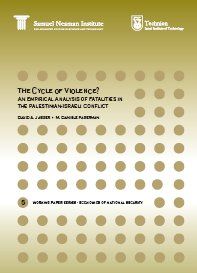This paper studies the dynamics of violence in the Palestinian-Israeli conflict since the outbreak of the Second (or “Al-Aqsa”) Intifada in September 2000, during which more than 3,800 Palestinians and more than 1,000 Israelis have been killed. The conflict has followed an uneven pattern, with periods of high levels of realized violence and periods of relative calm. Using data on the number of deaths occurring each day between September 2000 and January 2005, we estimate reaction functions for both Israelis and Palestinians and find evidence of unidirectional Granger causality from Palestinian violence to Israeli violence, but not vice versa. This finding is consistent whether we look only at the incidence of fatalities or whether we look at the level of fatalities, and is robust to the specification of the lag structure and the level of time aggregation. We conclude that, despite the popular perception that Palestinians and Israelis are engaged in “tit-for-tat” violence, there is no evidence to support that notion
 / Publications / The Cycle of Violence? An Empirical Analysis of Fatalities in the Palestinian-Israeli Conflict
/ Publications / The Cycle of Violence? An Empirical Analysis of Fatalities in the Palestinian-Israeli Conflict











